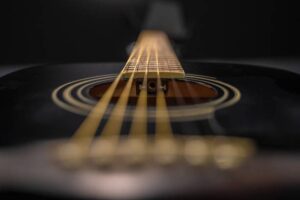Gibson guitar has been one of the most critical players in acoustic guitar development. They developed iconic body shapes like the J-45 and Southern Jumbo that resonate today.
They also pioneered various neck profiles, including the classic ’50s, slim-taper and modern ’60s models. This gives musicians their choice of what will best fit them.
Founded in 1902
 Gibson’s history is a story of innovation and success. It started as Orville Gibson’s part-time hobby and has grown into an iconic American brand spanning multiple generations and styles of music. Gibson is credited with many of the significant innovations in guitars and is known worldwide for its quality and high-end sound.
Gibson’s history is a story of innovation and success. It started as Orville Gibson’s part-time hobby and has grown into an iconic American brand spanning multiple generations and styles of music. Gibson is credited with many of the significant innovations in guitars and is known worldwide for its quality and high-end sound.
In the 1920s, the popularity of guitars began to grow, and Gibson responded with several new models, including their first flat-top acoustic guitars. They diversified their lineup with more traditional arch-top f-hole guitars as well. One of their most significant innovations was the L-5, a solid-body acoustic guitar that used Loar’s innovations to build a specific pitch into the body, an industry first.
During the Great Depression, Gibson struggled, but they continued to innovate despite this. In 1934, they introduced the Super 400, a substantial 18-inch comprehensive arch-top guitar that broke away from traditional design and established higher standards for craftsmanship and decoration. The company also expanded their acoustic line to include the Nick Lucas model, the first recording artist-endorsed acoustic guitar.
After the war, Gibson saw a postwar boom in demand and was purchased by Chicago Musical Instruments, a guitar wholesaler. The new owners continued to push for innovation, hiring Ted McCarty in 1948, who would become company president from 1950 to 1966. During this time, Gibson grew exponentially and was the first to make an electric guitar that utilized solid woods (Maple for the top and mahogany for the back) and allowed for a cutaway – empowering players to reach previously unobtainable upper frets.
Les Paul was a massive part of this growth and helped to introduce a new generation of guitar players to the Gibson brand. In 1954, Gibson employee Ted McHugh created the adjustable truss rod. In 1957, Seth Lovers invented the humbucker, a stack of two single-coil pickups with reversed polarities that virtually eliminated 60-cycle noise. This significant advancement in pickup technology opened up a whole new world of possibilities for guitars. For more information about the Gibson guitar, click here.
Innovations
Gibson has always been a trailblazer in guitar design. Their acoustic models, like the Southern Jumbo and J-45, remain iconic body shapes. But it was the Les Paul that truly revolutionized electric guitar playing – allowing never-before-seen upper fret access, it empowered players and altered the landscape of music forever.
Today’s guitars are much more complex, with many features allowing players to tailor their tone precisely to their needs. For example, the Tune-o-Matic bridge enables a player to adjust the overall bridge height and individual string saddles. This gives a player the flexibility to compensate for climate changes, string gauge variations, or other factors that may cause intonation problems.
While Orville Gibson laid down the foundations of the modern Gibson, many of their innovations came from Tedd McHugh. He was responsible for the adjustable truss rod and the height-adjustable bridge system, both vital to current Gibson guitar production.
In the 1950s, Les Paul was getting frustrated with the limited accessibility of the upper register on his acoustic guitar. McCarty teamed up with him to create a new solid-body electric guitar, the Les Paul Standard. While a solid maple Les Paul would have been incredibly heavy, the combination of mahogany and Maple meant the guitar was still highly playable and lightweight. This new design would become the standard in countless hits by artists of all genres.
This semi-hollow body guitar combines the sustain of a hollow body with the feedback-reducing properties of a solid body. It is a popular choice amongst jazz musicians for its warm sound and organic feel but has also been used by rock bands and singers. Gibson has continued to innovate their guitar line since the introduction of the Les Paul. The ES-335 is an excellent example of how the company has evolved its designs to keep up with changing tastes and technology demands.
The Gibson Innovations division was founded in 1992 and aims to meld modern technology with the classic guitar. The division has expanded through acquisitions, including Onkyo Corporation, TEAC, and Woox consumer electronics. Its operations are now headquartered in Memphis and include a 127,620-square-foot complex dedicated to acoustic instruments.
The Les Paul
The Les Paul is Gibson’s flagship electric guitar. Unlike a Telecaster, it has a solid body instead of a hollow one, and its set-neck construction makes for a more comfortable instrument to play than a bolt-on neck. It also has two pickups and a trapeze tailpiece, giving it a throaty tone with plenty of mid-range bites. The classic Les Paul has various finish options, from subtle two-tone sunburst to deep wine red. For more information about the Gibson guitar, click here.
